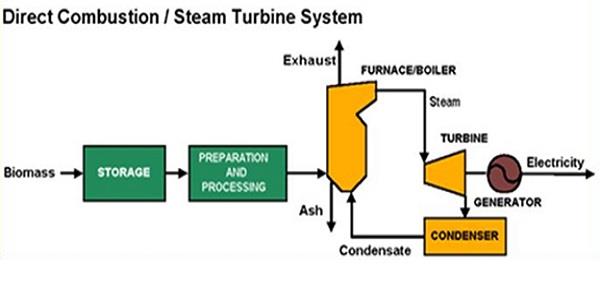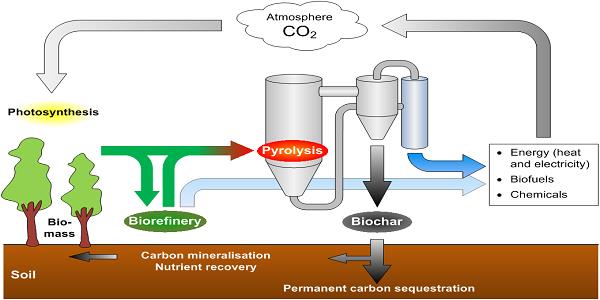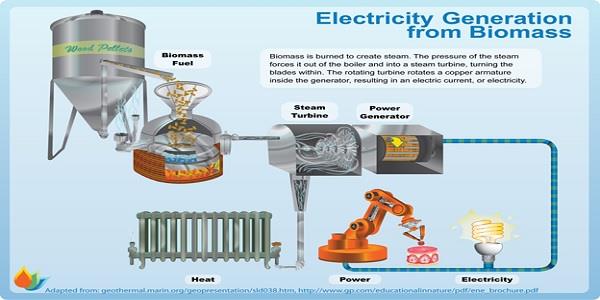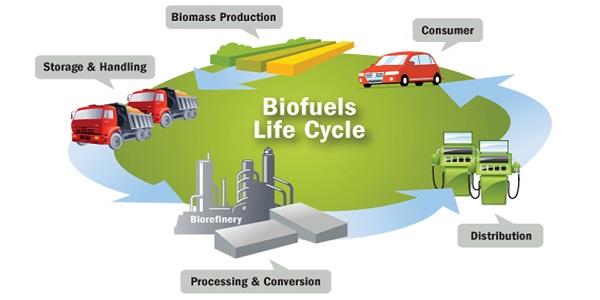Biomass energy is largely touted as the best alternative to petroleum and its derivatives in electricity generation. Biomass is a complex term referring to agriculture residues, plant materials, human waste, and other combustible residues. From these materials, we can derive bioenergy, which is eco-friendly, sustainable and renewable compared with fossil fuel energy production.

Human beings have discovered the efficiency of biomass such as wood pellets, cow dung, grass clippings, sugarcane bagasse in making fire for their everyday energy needs. However, such methods are not that efficient when compared to electricity generation methods. Today biomass has gained popularity in many countries as a viable source of energy. Biofuels are also replacing fossil fuels in some cars.
There is more to biomass which we will unfold in this article. We will be exploring the biomass energy basics, social and environmental impacts, economic effects, advantages and disadvantages of biomass energy, and the applications (uses) of this energy.
Bioenergy Basics
How does biomass energy work?
This is a basic question that most ask regarding how this energy works and how it is generated. As aforementioned, biomass refers to plants and animals’ materials that are used to generate electricity. There is a biomass plant (see the picture below) that is used to produce electricity by burning biomass in a combustor/furnace.
While direct combustion is not the only method of producing bioenergy, it remains the popular effective method. Other modern technologies produce a combustible gas out of biomass while others use pyrolysis to replace fossil fuels.
In the furnace or boiler of the biomass-fired plant, there could be sawdust, wood pellets, wood chips, or bio-oil. Heating water using these materials will yield steam that will activate the turbine which is connected to the generator, and ultimately generate electricity. As seen in the picture, there is the condenser which will condense the liquid back to the furnace to be reheated and electricity production will be continuous.
Bioenergy generating methods
There are many ways, as we have cited above, that biomass is generated into energy. Nonetheless, there are a few discussed below which include biochemical, thermochemical, chemical, and thermal conversion.
Biochemical conversion of biomass
To convert biomass into biochemical energy, microorganisms are used to produce ethanol. In particular, fuels and fertilizers are produced using biological and fermentation processes. In this quest, fermentation and anaerobic digestion are the main processes utilized. The anaerobic process uses microorganisms to breakdown organic material in oxygen-free settings. The production of biogas and methane from crops and manure is achieved through anaerobic digestion.
Fermentation, on the other hand, uses yeast to convert carbohydrates into bioethanol. This is a multi-stage process wherein crops may be combined with water in the first stage, and then heat and enzymes are used to break down the materials. Some enzymes will convert carbohydrates into sugars. Eventually, the alcohol is produced. It is a complex process beyond the scope of this article.
Chemical Conversion of Biomass
This process entails converting biomass other forms of energy using chemical reactions. The most common chemical reaction is the one that involves transesterification whose end-products are soaps, glycerin, and biodiesel. Fatty acids bond to alcohol to make them combustible.
Thermochemical Conversion of Biomass
The thermochemical processes convert biomass into chemicals and gases, and these processes are multi-stage. That’s where gasification comes in place and converts biomass into gas using extremely high temperatures approximately 800 degrees Celsius. In thermochemical conversion, the first stage is where solid biomass is transformed into gas, then gas into oils, and then oils into syngas.
Thermal Conversion of Biomass
This step involves using heat to transform solid biomass into useful energies. The technologies used in this stage include combustion, gasification, and pyrolysis. In combustion, biomass is burned in an oxygen-rich environment. The steam can be produced to provide heating and cooling applications or to turn turbines which then generate electricity. We have already explained direct combustion in electricity production above under biomass energy basics.
There is a co-firing practice where biomass is mixed with fossil fuels to produce electricity. This attempt saves some portions of fossil fuels. It also contributes to less carbon dioxide emissions into the atmosphere. The production of heat and electricity is also possible at the same time with biomass in a process called co-generation.
Under thermal conversion, there is also pyrolysis which undertakes biomass combustion under low oxygen levels, high-pressure conditions and high temperatures over 430 C. The process yields biofuels and biochar (a solid residue).
Types of Biofuels
There are various types of biofuels today in the industry. Biomass energy examples include biodiesel which is made from vegetable oils and animals fats; green diesel that is extracted from plant sources and algae; bioethanol derived from sugarcane in Brazil and corn in the US; and biogas extracted from animal manure and other organic materials.
Uses Of Biomass Energy
We explore the applications of biomass energy in electricity production, heating, and biofuels in cars. These are the main uses of bioenergy.
1). Electricity Production
Perhaps the main use in today’s world, electricity production from biomass-fired plants is on the table for discussion in many countries. Direct combustion system is the most common pathway used in this regard. The system burns biomass in furnaces and boilers to produce steam that will turn turbines and subsequently generate electricity by activating the electric generator.
A biomass-fired power plant will typically have furnace/combustor, pumps, turbine, condenser, electric generator, fuel storage, handling equipment, boiler, fans, automated system control, exhaust controls, and the cooling tower. The picture below illustrates the process:
2). Heating
Biomass heaters are potential replacements for fossil fuel heaters. The boilers can burn wood pellets, wood chips, sawdust, logs or any other type of biomass. They are connected to your home heating system and can provide heat to the home or heat your water. Already many households, particularly in rural areas, are using biomass such as wood chips and logs to burn stoves in winter to provide heat. Using biomass-fueled heaters has proven to be more efficient and potential alternative for both the urban and rural households.
3). Powering cars using biofuels
Biofuels have proven to be efficient and effective in powering modern cars and boost their performance. Ethanol is the common biofuel used to power cars. The United States produces bioethanol from corn while Brazil, for example, produces it from sugarcane. Biofuels are generally derived from sugar fermentation. They emit less carbon dioxide and are cost-effective. Countries underprivileged with fossil fuel reserves can make use of biofuels to power their cars. Biofuel can be blended with either diesel or petrol. If blended with petrol, a maximum of 10% bioethanol is required and if paired with diesel a maximum of 5% biodiesel is required.
Advantages and Disadvantages of Biomass Energy
Biomass energy has its ups and downs as well. We will highlight these advantages and disadvantages below to help you decide whether to consider bioenergy or not. But, compared with non-renewable fossil fuels, biomass energy carries more advantages that outweigh the disadvantages.
Advantages
- It is a renewable and sustainable energy because the animal or human waste and plants materials are always available
- No sulfur or mercury emission into the atmosphere
- Minimal nitrogen release
- Biofuels used in cars
- Biomass boilers efficiently heat homes
- Cost-effective source of energy
- Eliminates landfills because waste is taken for electricity production
- It is carbon-dioxide neutral because the amount released into the atmosphere is almost equal to the amount taken when plants grow again.
Disadvantages
- Competition with food production. The crops designated for energy production will consume much of the land that could be used to plant food to feed the hungry households
- Emits carbon dioxide which has to be offset by re-planting of trees
- Methane gas emission but not too adverse
- Risk of deforestation
- Not energy efficient compared to fossil fuels so other may be discouraged to replace fossil fuels completely
- Costly – capital cost in constructing the infrastructure for large scale productions
- Consumers must pay to get the energy on a continuous basis
Social and Environmental effects
Biomass energy is tied to some social and environmental effects. The negative effects of biomass power on the environment include the release of carbon dioxide. However, this amount of carbon dioxide is not necessarily damaging to the environment because the trees, when planted, consume almost the same amount. As thus, this makes biomass energy a carbon-neutral source.
The social impacts of biomass power plant are also, considerably, many. The plants will produce electricity for a country and negate the current tensions that countries have with fossil fuel ownership. There will be more energy generation that will benefit more citizens of the country including those in rural areas. Many people in some countries flock to cities where fossil fuel energy is abundant. The abundance of biomass energy production in rural environments will compensate for that.
The biomass plant requires space and getting this space in rural areas may be a challenge. You may have to lease land to construct the plant. Some people might object to the emissions of gases because they find them unhealthy despite the benefits. These are some of the social impacts of biomass power plants.
Economic effects of Biomass Mass
The energy will save many people money. With the rising costs of fossil fuels, biomass energy can come to the rescue of many countries. In other words, there are positive outlooks to the future and economic impacts of biomass. The other positive side of biomass is that individual households can actually sell biomass to energy producers and make money out of that. It will help reduce the cost of disposing of waste to designated landfills.
The production of biofuels such as ethanol is also carrying positive economic outlooks. As a result, modern cars can benefit from these fuels.
Biomass Energy Facts and Figures
Here we explore important facts about biomass energy in the United States [1] and the rest of the world. In general, biomass fuels have contributed 5% of energy in the US in 2016. However, the country plans to increase this figure. Bioethanol takes up 48% of this 5% followed by wood-derived biomass with 41% and municipal waste with 11%.
Worldwide, biomass energy has contributed 10% to global energy production in 2012, a figure envisaged skyrocketing if all stakeholders come to the forefront and leverage on this potential energy source. In fact, biofuels contributed 2068 trillion BTU [2] the previous year.
Power generation Potential
Experts have mixed views about the future of biomass energy. Other countries such as Germany have lost hope in using biomass energy as the renewable source [3]. Instead, the country prioritizes wind and solar as the winners. Other experts are predicting a great potential of the energy. Bioenergy has its issues such as the feedstock needed to produce it versus some environmental impacts such as emissions. Although it emerges as the outright winner compared with fossil fuels, it does not come near solar power, hydropower, wind energy or tidal energy.
[content_band border=”all” inner_container=”true”] [custom_headline style=”margin-top: 0;” level=”h3″ looks_like=”h3″]Statistical References[/custom_headline]- Biomass Explained
- Does bioenergy have a green energy future in the US?
- On Biofuels, part 3: The future of bioenergy
[/content_band]
Conclusion
Biomass energy is a potential alternative to fossil-fuel generated electricity. There are abundant biomass materials to produce electricity cost-effectively. Biomass energy production comes with minimal greenhouse gas emissions into the atmosphere. However, that’s insignificant compared with fossil fuels. By the way, the carbon dioxide emitted will be taken away again by plants when they are grown. Biomass is also a significant source of heating in many households. Many households have been using woods in stoves to provide heating particularly in winter, but the provision of biomass boilers is negating the efficacy of those stoves.
We have explored several technologies used in biomass energy production as well as several uses and applications. In addition, we’ve considered the advantages and disadvantages of giving you comprehensive knowledge into the future of biomass energy.
Given the flexibility of biomass energy production, many countries with no fossil fuel reserves can make use of this opportunity because biomass is almost available everywhere. It is immune to the rising costs of fossil fuels. There are good economic impacts of biofuels such as ethanol as it is widely used in cars.
